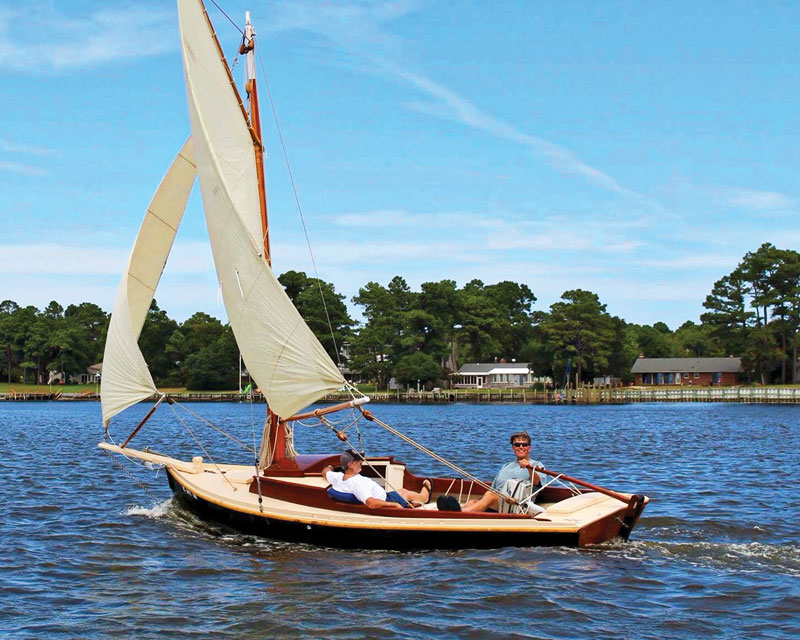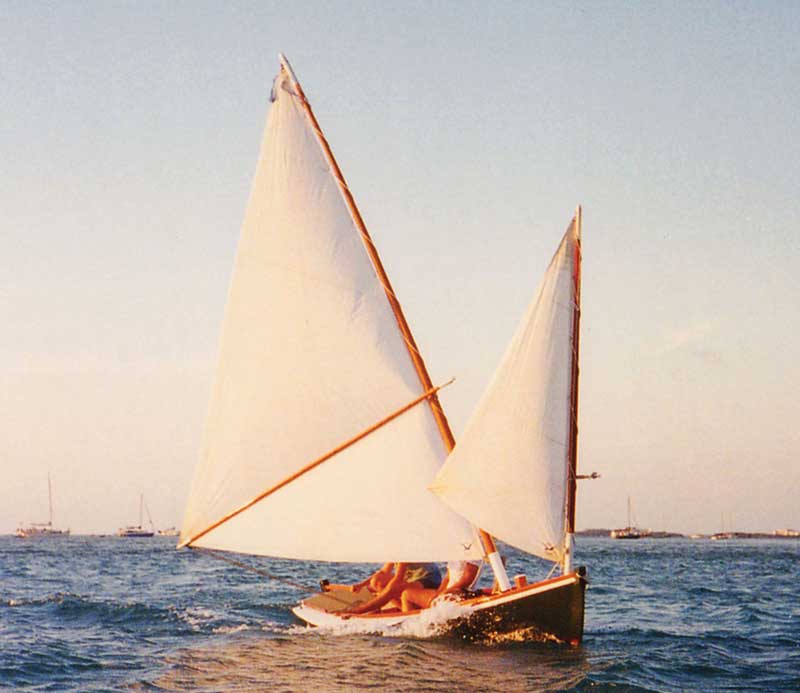Reuel Parker
The Maestro of Yacht Deco Design
 The Swansea Pilot 28, like its designer, displays a colorful character. Photo by Benjamin Mendlowitz
As a boating writer, I have been itching for years to revisit Capt. Reuel Parker, sometimes of Maine, but most times at sea or at work in Florida. You need to understand that while Parker fits the description of “Designer/Builder,” for me, he elevates his craft to a niche requiring way more hard work than the moniker implies. To my mind, he is a Builder/Designer, and there aren’t many like him in multiple respects, in any port in the world.
The Swansea Pilot 28, like its designer, displays a colorful character. Photo by Benjamin Mendlowitz
As a boating writer, I have been itching for years to revisit Capt. Reuel Parker, sometimes of Maine, but most times at sea or at work in Florida. You need to understand that while Parker fits the description of “Designer/Builder,” for me, he elevates his craft to a niche requiring way more hard work than the moniker implies. To my mind, he is a Builder/Designer, and there aren’t many like him in multiple respects, in any port in the world.
 Jack-of-all-trades Reuel Parker brings a workboat approach to his designs. Photo courtesy Reuel Parker
Those who know what a drawing board is understand the meaning of the term designer/builder. My twin brother, Chuck, and I probably qualify as that, having built two Blue Jay sailboats for fun and profit before graduating from high school. It can be useful for a yacht designer to have had some experience with building a boat. Often that makes for a better vessel in the end, and almost always it means an easier to build, thus a less expensive one. Parker is akin to a third brother to me, in my view, only he did every city-slicker yacht designer a giant step better. Parker has not only out-designed and out-built and out-worked most anybody I know; he has managed to live a life of raw adventure and not a little romance—all of which we know about due to his Renaissance skills as sea-captain, writer, and photographer.
Jack-of-all-trades Reuel Parker brings a workboat approach to his designs. Photo courtesy Reuel Parker
Those who know what a drawing board is understand the meaning of the term designer/builder. My twin brother, Chuck, and I probably qualify as that, having built two Blue Jay sailboats for fun and profit before graduating from high school. It can be useful for a yacht designer to have had some experience with building a boat. Often that makes for a better vessel in the end, and almost always it means an easier to build, thus a less expensive one. Parker is akin to a third brother to me, in my view, only he did every city-slicker yacht designer a giant step better. Parker has not only out-designed and out-built and out-worked most anybody I know; he has managed to live a life of raw adventure and not a little romance—all of which we know about due to his Renaissance skills as sea-captain, writer, and photographer.
Parker was born in Colorado, spent his early years mostly on the South Shore of Long Island, at Bay Shore, and was a self-styled water rat. He remembers toddling atop a tall pier and gazing down onto the deck of a true working schooner. He says that was all it took: He’s had a lifelong addiction to boats. When he was about age 4, his family moved to Bangor, Maine, where his dad was a Unitarian minister. Maine being a nautical paradise, Parker’s sea-love infection spread alongside a love of the state. By about 12, he built his first boat and got his start in yacht design.
 Typical of Parker’s designs, this 21-footer has ample sail area.
Well, not exactly yachts. Ever since spying that schooner, he’s always appreciated the virtues of working vessels, and has researched their practical advantages. An avid reader of Chapelle and more obscure tomes on fishing and piloting vessels, he investigated non-yachty features such as ease of construction, seaworthiness, and sufficient frugality as to almost guarantee profitable use. Parker has designed more than 120 boats. Most of the prototypes he would construct in Florida, alongside a bevy of his so-called angels, and one or two close friends, including his late boatbuilding partner Bill Smith, with whom he worked for 37 years. (Reuel’s angels became an attractive aspect of his islands-cruising lifestyle, which emulates but arguably slightly outdoes that of Jimmy Buffett.)
Typical of Parker’s designs, this 21-footer has ample sail area.
Well, not exactly yachts. Ever since spying that schooner, he’s always appreciated the virtues of working vessels, and has researched their practical advantages. An avid reader of Chapelle and more obscure tomes on fishing and piloting vessels, he investigated non-yachty features such as ease of construction, seaworthiness, and sufficient frugality as to almost guarantee profitable use. Parker has designed more than 120 boats. Most of the prototypes he would construct in Florida, alongside a bevy of his so-called angels, and one or two close friends, including his late boatbuilding partner Bill Smith, with whom he worked for 37 years. (Reuel’s angels became an attractive aspect of his islands-cruising lifestyle, which emulates but arguably slightly outdoes that of Jimmy Buffett.)
Parker sells plans that are detailed and understandable enough for amateur boatbuilders from his website, parker-marine.com. My intention in this column is to show off what he designs, with a hope that more Mainers will tackle his stock plans. I chose to focus on his Swansea Pilot Schooner 28 for two reasons: It is a relatively smaller project and thus cheap and easy to build. But mostly, among his always artistic designs, this, to me, is one of his masterpieces.
 Peregrine’s hard dodger over the center cockpit provides protection from the elements for skipper and crew.
This design does look like a Bristol Channel pilot hull. It has the plumb stem, long bowsprit, and overhanging counter stern. But it improves in many ways on the cutters that brought harbor pilots to merchant vessels bound into Cardiff, Bristol, Swansea, and Newport. All these ports dried to the hard at low tide. Parker’s version ideally suits a life in the Bahamas. There, widely separated boatyards share the advisability of a long, rugged keel on which to careen, intentionally or otherwise. Draft at the aft heel is about 4 feet. That’s with a bunch of young salts aboard, diving tanks full, and snorkeling and fishing gear and provisions loaded.
Peregrine’s hard dodger over the center cockpit provides protection from the elements for skipper and crew.
This design does look like a Bristol Channel pilot hull. It has the plumb stem, long bowsprit, and overhanging counter stern. But it improves in many ways on the cutters that brought harbor pilots to merchant vessels bound into Cardiff, Bristol, Swansea, and Newport. All these ports dried to the hard at low tide. Parker’s version ideally suits a life in the Bahamas. There, widely separated boatyards share the advisability of a long, rugged keel on which to careen, intentionally or otherwise. Draft at the aft heel is about 4 feet. That’s with a bunch of young salts aboard, diving tanks full, and snorkeling and fishing gear and provisions loaded.
Parker is, need I repeat, a boatbuilder’s designer. He might have invented the welded-steel/lead-filled external ballast idea. One of the most difficult and most expensive parts of a sailboat project is the ballast for the keel. Normally it requires pouring molten lead into a throw-away cavity mold that has been smeared with water glass. Parker’s solution is a welded steel long-box that is integral and not only defines the shape, but once all’s cooled and hardened, provides a protective skin that will not dent or deform. I should point out that external lead at the very bottom of a traditional hull is a huge benefit compared to the internal waste iron or even bilge-rocks of all Western Approaches pilot vessels.
 Panther, a commuter 32.5, was built by Hylan and Brown in Brooklin, Maine, with Parker’s oversight. Raised sheer forward is a common feature of his powercruisers.
In fact, Parker has invented or repurposed lots of materials in search of economy, which end up shown in his blueprints. You’ll see, for example, bilge voids filled with a mixture of coarse sand and resin. Everything he suggests on his plans has been proven by his experimentation in past boats he actually built.
Panther, a commuter 32.5, was built by Hylan and Brown in Brooklin, Maine, with Parker’s oversight. Raised sheer forward is a common feature of his powercruisers.
In fact, Parker has invented or repurposed lots of materials in search of economy, which end up shown in his blueprints. You’ll see, for example, bilge voids filled with a mixture of coarse sand and resin. Everything he suggests on his plans has been proven by his experimentation in past boats he actually built.
I will never forget that the huge rudder in his schooner Leopard was turned not by some expensive worm gear device of solid bronze from a Nova Scotia foundry, but by a very old contrivance salvaged from an early-20th-century steam yacht. Better yet was the steering gear on his first big world cruiser, Fisher’s Hornpipe, which was fitted with a rack-and-pinion affair out of a 1948 White-brand bus. He purchased the steering gear from a California junkyard for $10.
 Parker’s profile drawing of the Swansea Pilot displays the color and style of a true artist.
I first met Parker in person while he cruised Penobscot Bay in his self-built 75-foot Leopard. (See MBH&H issue 158, May/June 2019.) Invited aboard, I appreciated that he’d set up a tiny little cabin configured just for designing boats, by computer or by hand. I wanted to believe that the stock plan for his Swansea Pilot Schooner was conceived there, but Parker recently informed me that it was drawn in Key West for sailor and boatbuilder Lucy Trinder in 1997.
Parker’s profile drawing of the Swansea Pilot displays the color and style of a true artist.
I first met Parker in person while he cruised Penobscot Bay in his self-built 75-foot Leopard. (See MBH&H issue 158, May/June 2019.) Invited aboard, I appreciated that he’d set up a tiny little cabin configured just for designing boats, by computer or by hand. I wanted to believe that the stock plan for his Swansea Pilot Schooner was conceived there, but Parker recently informed me that it was drawn in Key West for sailor and boatbuilder Lucy Trinder in 1997.
Parker loves schooners. He’s drawn lots of designs with gaff—or less often Marconi sloop—rigs, and even reconfigured the Swansea Pilot for those sail plans. But I chose the schooner option for many reasons, one of them being the man has the heart and soul of a schoonerman. (He often puts cargo holds in his big designs). And I love the look—the outrageousness—of this particular schooner.
 It takes a master builder to lay out a perfect waterline on a lapstrake boat.
In talking with Parker, I always get an education. He told me several more rationales for the sharply raked masts of traditional American schooners and Baltimore clippers than those I already knew about. Basically, they look and sail faster, are more seaworthy, and can be handled by one person. (That’s how it was done in the English Channel. Pilots went out with one paid hand, who steered home after the pilot jumped onto a merchant ship.)
It takes a master builder to lay out a perfect waterline on a lapstrake boat.
In talking with Parker, I always get an education. He told me several more rationales for the sharply raked masts of traditional American schooners and Baltimore clippers than those I already knew about. Basically, they look and sail faster, are more seaworthy, and can be handled by one person. (That’s how it was done in the English Channel. Pilots went out with one paid hand, who steered home after the pilot jumped onto a merchant ship.)
I found out from Parker that most schooners worldwide in the 17th and 18th centuries employed a “lug foresail” (without a boom) because it was more forgiving. A man working alone didn’t want to contend with being knocked by a pole rather than canvas. Also, such a rig is more powerful because the foresail has more curvature, making it akin to a genoa jib set behind a nice straight leading edge, the foremast.
 With its shoal draft and fold-up rudder, this Parker design shows off the joys of gunk-holing in shallow waters.
But the one thing that most drew me to the Swansea Pilot design was that it is so pretty. The way Parker has illustrated the outboard profile/sail plan, in perfectly selected colors, the boat resembles a John Alden schooner, with a low forward coachroof snugged in behind high bulwarks. But that is nothing but paint and artistry! In fact, the hull is flush-decked out to a sheer clamp. Which of course makes for lots more room—and the feeling of room—below. How important that is in a little boat with only sitting headroom!
With its shoal draft and fold-up rudder, this Parker design shows off the joys of gunk-holing in shallow waters.
But the one thing that most drew me to the Swansea Pilot design was that it is so pretty. The way Parker has illustrated the outboard profile/sail plan, in perfectly selected colors, the boat resembles a John Alden schooner, with a low forward coachroof snugged in behind high bulwarks. But that is nothing but paint and artistry! In fact, the hull is flush-decked out to a sheer clamp. Which of course makes for lots more room—and the feeling of room—below. How important that is in a little boat with only sitting headroom!
As to Parker’s artistry, I’ve saved the best (and the most conspicuous) for last. But first, allow me to digress.
One of the things I kvetch about in my old age is the demise of how it once was in yacht voyaging. One of the best things about cruising afar was to encounter especially gorgeous wooden vessels. Some were merchant vessels, some rustic native craft, and a few the aesthetic treasures of the fortunate few, designed by Golden Era yacht designers. In those days if you scoped out an anchorage, you’d first “speak,” or hail a moored boat to inquire whether you might invade their privacy at a respectable distance. Part of this ritual was to soak up the beauty of their floating home and dispatch a compliment as to its design and execution.
So, in the hallowed days of yore, beauty was the first and best attribute. But in all of artistic painting, as with cruising, there’s always a plus for something unique and distinctive. Parker has achieved this in spades.
 Some Parker designs are ideally suited for extroverts who revel in being approached.
While Chesapeake clippers gained distinction with sharply raked masts, I was instantly captivated by Parker’s treatment. He is the ultimate schooner historian, so he knows why masts were raked and he even knows why Gloucester fishing schooners always bent the fore-topmast in a curve toward the vertical, with tight setup of the headstay. (Something I didn’t know.) He was aware that all traditional schooners rake the aft mast a little bit more, because the human eye always pulls things together aloft. He has overdone tradition by a country mile. But as is said so often about art, “I know what I like.”
Some Parker designs are ideally suited for extroverts who revel in being approached.
While Chesapeake clippers gained distinction with sharply raked masts, I was instantly captivated by Parker’s treatment. He is the ultimate schooner historian, so he knows why masts were raked and he even knows why Gloucester fishing schooners always bent the fore-topmast in a curve toward the vertical, with tight setup of the headstay. (Something I didn’t know.) He was aware that all traditional schooners rake the aft mast a little bit more, because the human eye always pulls things together aloft. He has overdone tradition by a country mile. But as is said so often about art, “I know what I like.”
And I especially like the splayed masts of this Swansea Pilot Schooner.
One time, when I was in the Bahamas, Parker found me at Regatta Point in Exuma and invited me to join him for dinner. He’d caught a very big fish, and he told me he was anchored way out in Red Shank Harbour. When I found him, he was aboard one of his outrageously interesting self-built schooners, this one with a modified Chinese junk rig. Upon arrival, I spied two or three of his angels aboard and realized why he was out there in the Red Shanks. Evidently dinner would be clothing-optional.
So forgive me, I have digressed with the undressed. The point I more intended to make is that Reuel’s design of the Swansea Pilot that we see here, anchored in lonely shallows anywhere, would be the first vessel you’d wish to “speak.” I like to call my own mix of nautical designs and businesses, “Yacht Deco.” And that’s what I will always love about this and any boat that was designed or built by Reuel B. Parker. He is the maestro of masters at yacht deco.
✮
Contributing author Art Paine is a boat designer, fine artist, freelance writer, and photographer who lives in Bernard, Maine.
Related Articles
Share this article:
2023 Maine Boat & Home Show

Join Us for the Maine Boat & Home Show!
Art, Artisans, Food, Fun & Boats, Boats, Boats
August 11 - 13, 2023 | On the waterfront, Rockland, Maine
Click here to pre-order your tickets.
Show is produced by Maine Boats, Homes & Harbors magazine.















